A Review of Termite Species and Their Distribution in Thailand
Abstract
:Simple Summary
Abstract
1. Introduction
2. Materials and Methods
2.1. Selection Criteria
2.1.1. Publications in Database
2.1.2. Annual Reports/Theses
2.2. GIS Map Construction
3. Results
4. Conclusions
Supplementary Materials
Author Contributions
Funding
Institutional Review Board Statement
Data Availability Statement
Acknowledgments
Conflicts of Interest
References
- Jones, D.T.; Eggleton, P. Sampling termite assemblages in tropical forests: Testing a rapid biodiversity assessment protocol. J. Appl. Ecol. 2000, 37, 191–203. [Google Scholar] [CrossRef]
- Ahmad, F.; Fouad, H.; Liang, S.Y.; Hu, Y.; Mo, J.C. Termites and Chinese agricultural system: Applications and advances in integrated termite management and chemical control. Insect Sci. 2021, 28, 2–20. [Google Scholar] [CrossRef] [PubMed]
- Lal, R. Tropical Ecology and Physical Edaphology; John Wiley and Sons: Chichester, UK, 1987. [Google Scholar]
- Abe, T.; Bignell, D.E.; Higashi, M. Termites: Evolution, Sociality, Symbioses, Ecology; Springer Science and Business Media: Dordrecht, The Netherlands, 2000. [Google Scholar]
- Su, L.; Yang, L.; Huang, S.; Su, X.; Li, Y.; Wang, F.; Wang, E.; Kang, N.; Xu, J.; Song, A. Comparative gut microbiomes of four species representing the higher and the lower termites. J. Insect. Sci. 2016, 16. [Google Scholar] [CrossRef] [Green Version]
- Duarte, S.; Nunes, L.; Borges, P.A.V.; Fossdal, C.G.; Nobre, T. Living inside termites: An overview of symbiotic interactions, with emphasis on flagellate protists. Arquipel. Life Mar. Sci. 2017, 34, 21–43. [Google Scholar]
- Lampert, N.; Mikaelyan, A.; Brune, A. Diet is not the primary driver of bacterial community structure in the gut of litter-feeding cockroaches. BMC Microbiol. 2019, 19, 238. [Google Scholar] [CrossRef]
- Zhou, J.; Duan, J.; Gao, M.; Wang, Y.; Wang, X.; Zhao, K. Diversity, Roles, and biotechnological applications of symbiotic microorganisms in the gut of termite. Curr. Microbiol. 2019, 76, 755–761. [Google Scholar] [CrossRef]
- Holt, l. Carbon mineralization in Northeastern Australia: The role of termites. J. Trop. Ecol. 1987, 3, 255–263. [Google Scholar] [CrossRef]
- Holt, l. Microbial activity in the mounds of some Australian termites. Appl. Soil. Ecol. 1998, 9, 183–187. [Google Scholar] [CrossRef]
- Rust, M.K.; Su, N.Y. Managing social insects of urban importance. Annu. Rev. Entomol. 2012, 57, 355–375. [Google Scholar] [CrossRef]
- Subekti, N.; Yoshimura, T.; Rokhman, F.; Mastur, Z. Potential for subterranean termite attack against five bamboo speciesin correlation with chemical components. Procedia Environ. Sci. 2015, 28, 783–788. [Google Scholar] [CrossRef] [Green Version]
- Siramon, P.; Ohtani, Y.; Ichiura, H. Biological performance of Eucalyptus camaldulensis leaf oils from Thailand against the subterranean termite Coptotermes formosanus Shiraki. J. Wood Sci. 2009, 55, 41–46. [Google Scholar] [CrossRef] [Green Version]
- Thipsantia, P. Biodiversity of Termites and Their Relationship to Dry Dipterocarp and Dry Evergreen Ecosystems at Sakaerat Environmental Research Station, Nakhon Ratchasima Province; Suranaree University of Technology: Nakhon Ratchasima, Thailand, 2011. [Google Scholar]
- Holmgren, N. Termitenstudien. 4. Versuch einer systematischen Monographie der Termiten der orientalischen Region K. Svenska Vetensk. Akad. Handl. 1913, 50, 1–276. (In German) [Google Scholar]
- Snyder, T.E. Catalog of the termites (Isoptera) of the world. Smithson. Misc. Collect. 1949, 112, 1–490. [Google Scholar]
- Krishna, K.; Weesner, T.J. Biology-of-Termites; Academic Press: New York, NY, USA; London, UK, 1969; Volume 1. [Google Scholar]
- Sornnuwat, Y.; Vongkaluang, C.; Takematsu, Y. A systematic key to termites of Thailand. Kasetsart J. (Nat. Sci.) 2004, 38, 349–368. [Google Scholar]
- Ahmad, M. Termites (Isoptera) of Thailand. Bull. Amer. Mus. Nat. Hist. 1965, 131, 1–111. [Google Scholar]
- Morimoto, K. Termite from Thailand. Bull. Gov. For. Explain. Stn. 1973, 257, 57–80. [Google Scholar]
- Davies, R.G. Termite species richness in fire-prone and fire-protected dry deciduous dipterocarp forest in Doi Suthep-Pui National Park, northern Thailand. J. Trop. Ecol. 1997, 13, 153–160. [Google Scholar] [CrossRef]
- Amornsak, W.; Sarnthoy, O.; Kirtibutr, N. New records of two Nasutitermitinae termites (Isoptera: Termitidae) from hill evergreen forest on Khao Kitchakut National Park in Thailand. Kasetsart J. (Nat. Sci.) 2003, 37, 421–428. [Google Scholar]
- Houseman, R.M. First record of Microcerotermes serrula (Desneux) (Isoptera: Termitidae) in Thailand. Entomol. News 2004, 115, 237–239. [Google Scholar]
- Inoue, T.; Takematsu, Y.; Yamada, A.; Hongoh, Y.; Johjima, T.; Moriya, S.; Sornnuwat, Y.; Vongkaluang, C.; Ohkuma, M.; Kudo, T. Diversity and abundance of termites along an altitudinal gradient in Khao Kitchagoot National Park, Thailand. J. Trop. Ecol. 2006, 22, 609–612. [Google Scholar] [CrossRef]
- Inoue, T.; Takematsu, Y.; Hyodo, F.; Sugimoto, A.; Yamada, A.; Klangkaew, C.; Kirtibutr, N.; Abe, T. The abundance and biomass of subterranean termites (Isoptera) in a dry evergreen forest of northeast Thailand. Sociobiology 2001, 37, 41–52. [Google Scholar]
- Choosai, C.; Mathieu, J.; Hanboonsong, Y.; Jouquet, P. Termite mounds and dykes are biodiversity refuges in paddy fields in north-eastern Thailand. Environ. Conserv. 2009, 36, 71–79. [Google Scholar] [CrossRef]
- Shaleh, I.; Jannual, N.; Hasin, S.; Kaewgrajang, T.; Raffiudin, R.; Nipitwattanaphon, M. Identification of fungus-growing termites and mutualistic Termitomyces from two provinces in Thailand. Int. J. Trop. Insect Sci. 2021, 41, 1555–1566. [Google Scholar] [CrossRef]
- Kuntha, C.; Thungrabeab, M.; Hanboonsong, Y.; Pisitkul, S. Survey of termites in the Khon Kaen University Campus; Academic Resource Center, Khon Kaen University: Khon Kaen, Thailand, 1988. [Google Scholar]
- Vongkaluang, C.; Sornnuwat, Y.; Charoenkrung, K.; Chutibhapakorn, S.; Yoko, T. Survey and Study on Ecology and Diversity of Termites in Eastern and Western Thailand. Chantaburi and Kanchanaburi Province. Available online: http://www.forest.go.th/forprod/research/abstract/1004.pdf (accessed on 4 July 2021).
- Sornnuwat, Y.; Charoenkrung, K.; Chaikuad, K. Termite Diversity on Ko Phra-Thong and Ko Ra, Phang-nga Province and the Effect Caused by Tsunami. Available online: http://www.rspg.or.th/articles/e_book/volume_1/pdf/doc_24.pdf. (accessed on 4 July 2021).
- Sornnuwat, Y. Survey and Study on Termites in Some National Park Areas. Chiang Mai and Lampang, Northern Thailand. Available online: http://forprod.forest.go.th/forprod/Entomology_Secter/PDF/details/1011T.PDF (accessed on 4 July 2021).
- Sornnuwat, Y.; Vongkaluang, C.; Chutibhapakorn, S. Survey and Study on Diversity of Termites in Secondary Dry Dipterocarp Forest and Dry Everygreen Forest at Srinakarin Dam National Park, Kanchanaburi Province, Western Thailand. Available online: http://forprod.forest.go.th/forprod/Entomology_Secter/PDF/details/1008T.PDF (accessed on 4 July 2021).
- Sornnuwat, Y.; Chutiphapakorn, S.; Naknilthong, S.; Prasong-Ngern, C. The Report of Termite Survey on Koh Khai and Koh Wiang in Pathio District, Chumphon Province. Available online: http://forprod.forest.go.th/forprod/Entomology_Secter/PDF/details/1012T.PDF (accessed on 4 July 2021).
- Teekatananont, W. Ecologocal Studies of Termites in Tropical Fruit Tree Plantation Ecosystem of Thailand; Kasetsart University, Office of the University Library: Bangkok, Thailand, 2002. [Google Scholar]
- RSPG. The Final Report of RSPG, Biological and Physical Resource Survey; RSPG: Bangkok, Thailand, 2010; pp. 210–213. [Google Scholar]
- Anan, C.; Pokasang, P.; Jitrawut, R.; Leosee, W. Diversity of Termite and Season Effect on Species Diversity in Rajamangala University of Technology Thanyaburi; Rajamangala University of Technology Thanyaburi: Pathum Thani, Thailand, 2010. [Google Scholar]
- Sookruksawong, S.; Vechklang, K.; Garcia, L.E.G.; Chaikuad, K.; Samerjai, N. Diversity and Role of Termites in Dry Dipterocarp and Mixed- Deciduous Forests at Nongrawiang Center in Nakhon Ratchasima Province; Sciences and Liberal Arts, Rajamangala University of Technology Isan: Nakhon Ratchasima, Thailand, 2018. [Google Scholar]
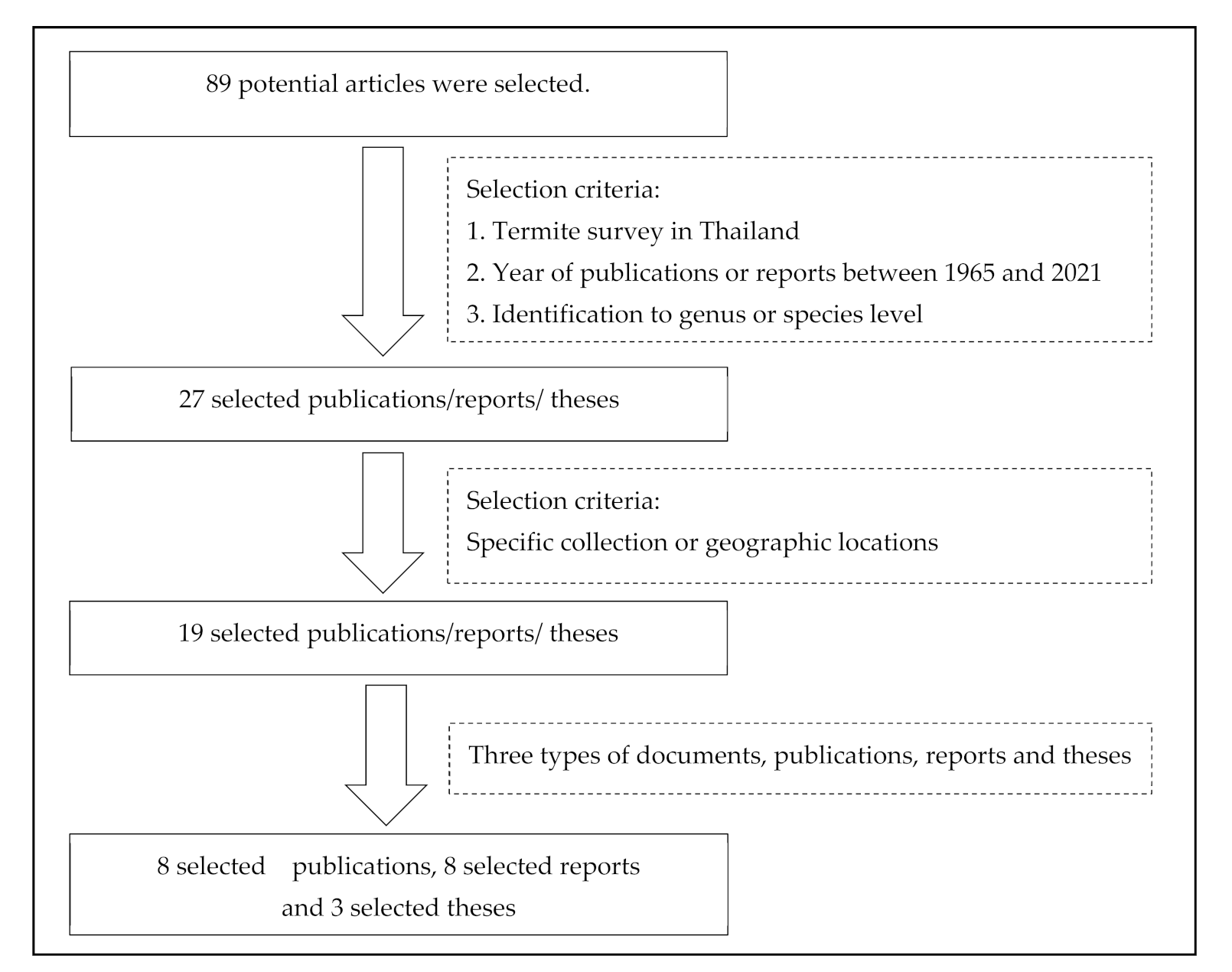

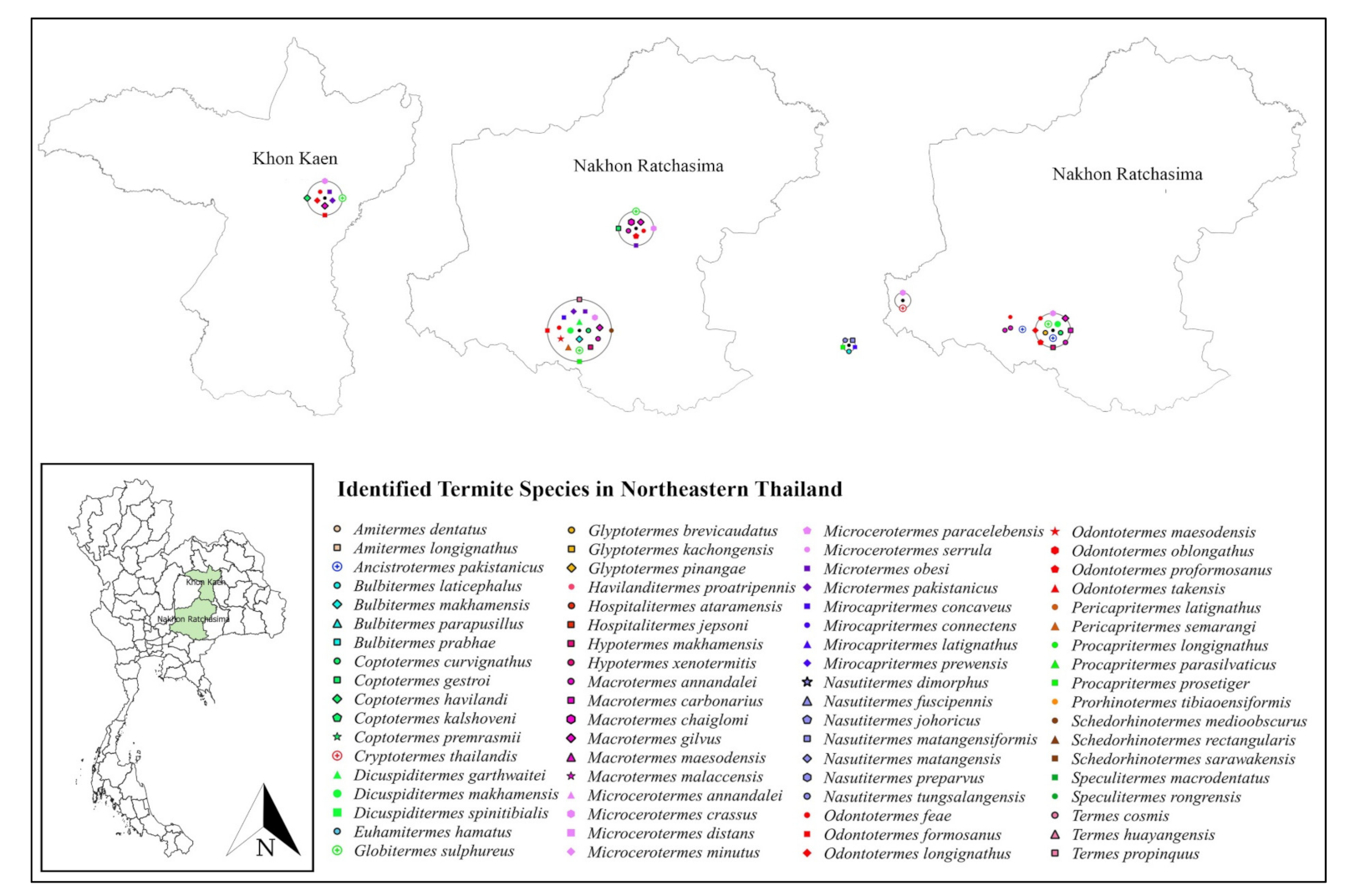
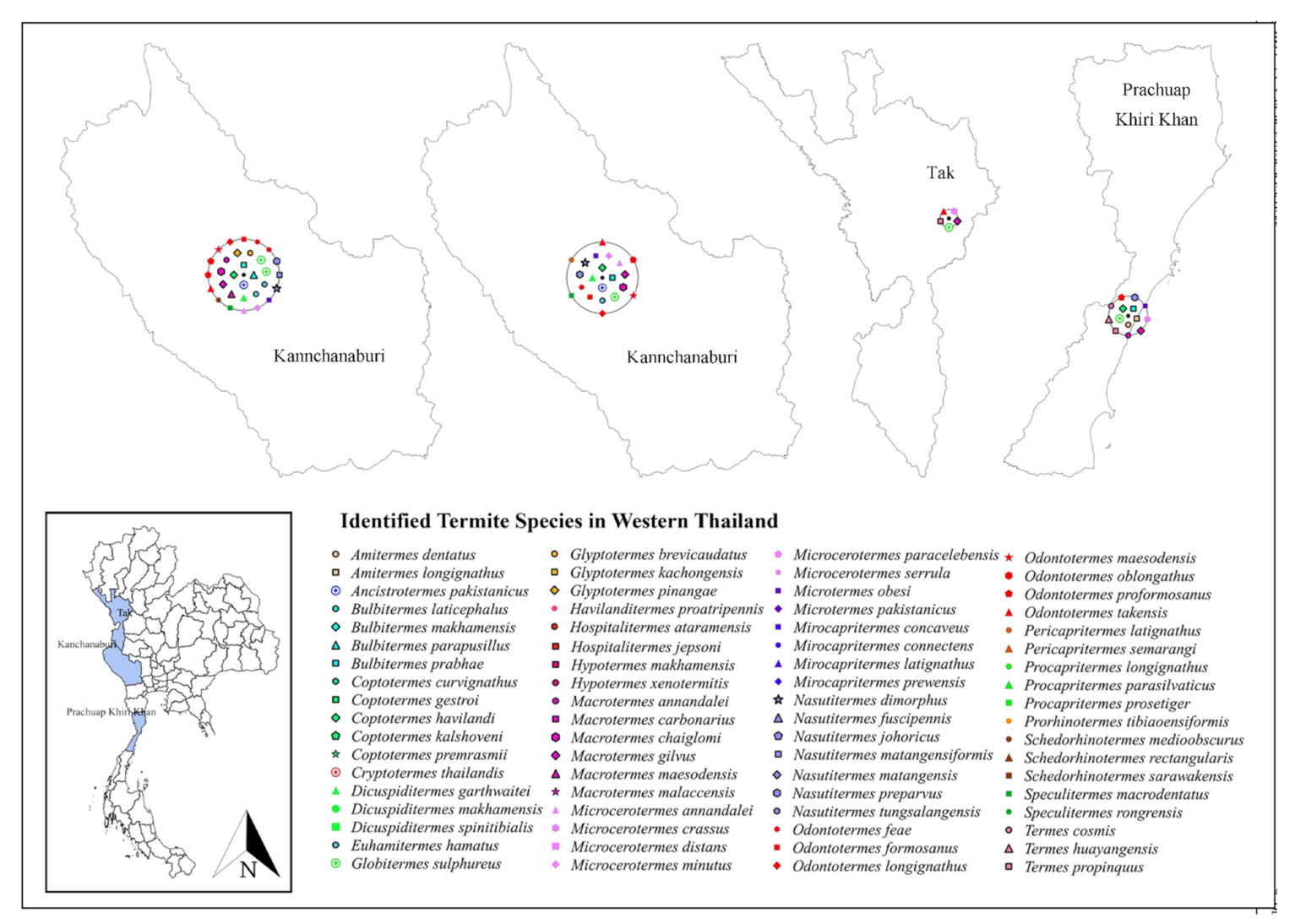
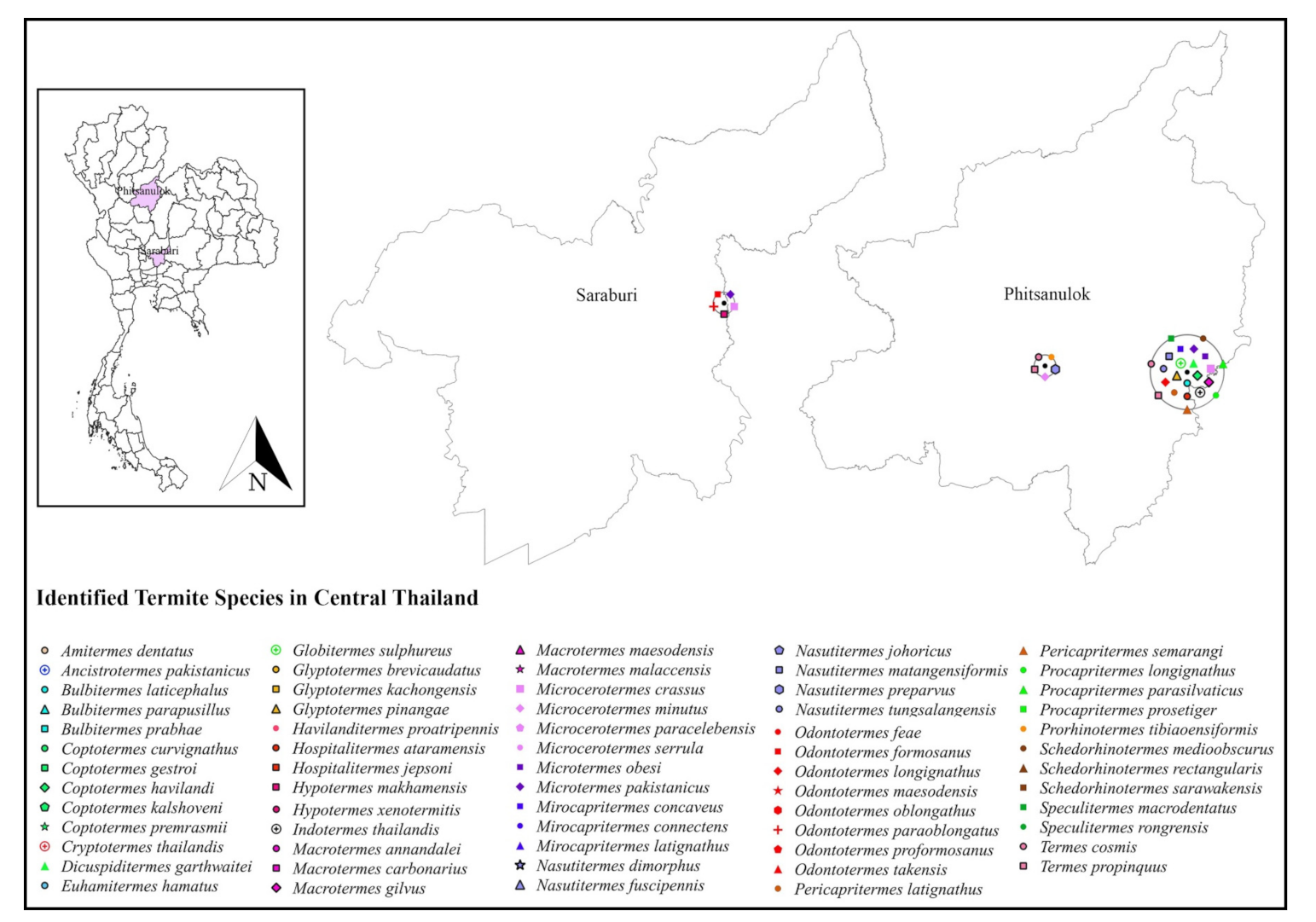
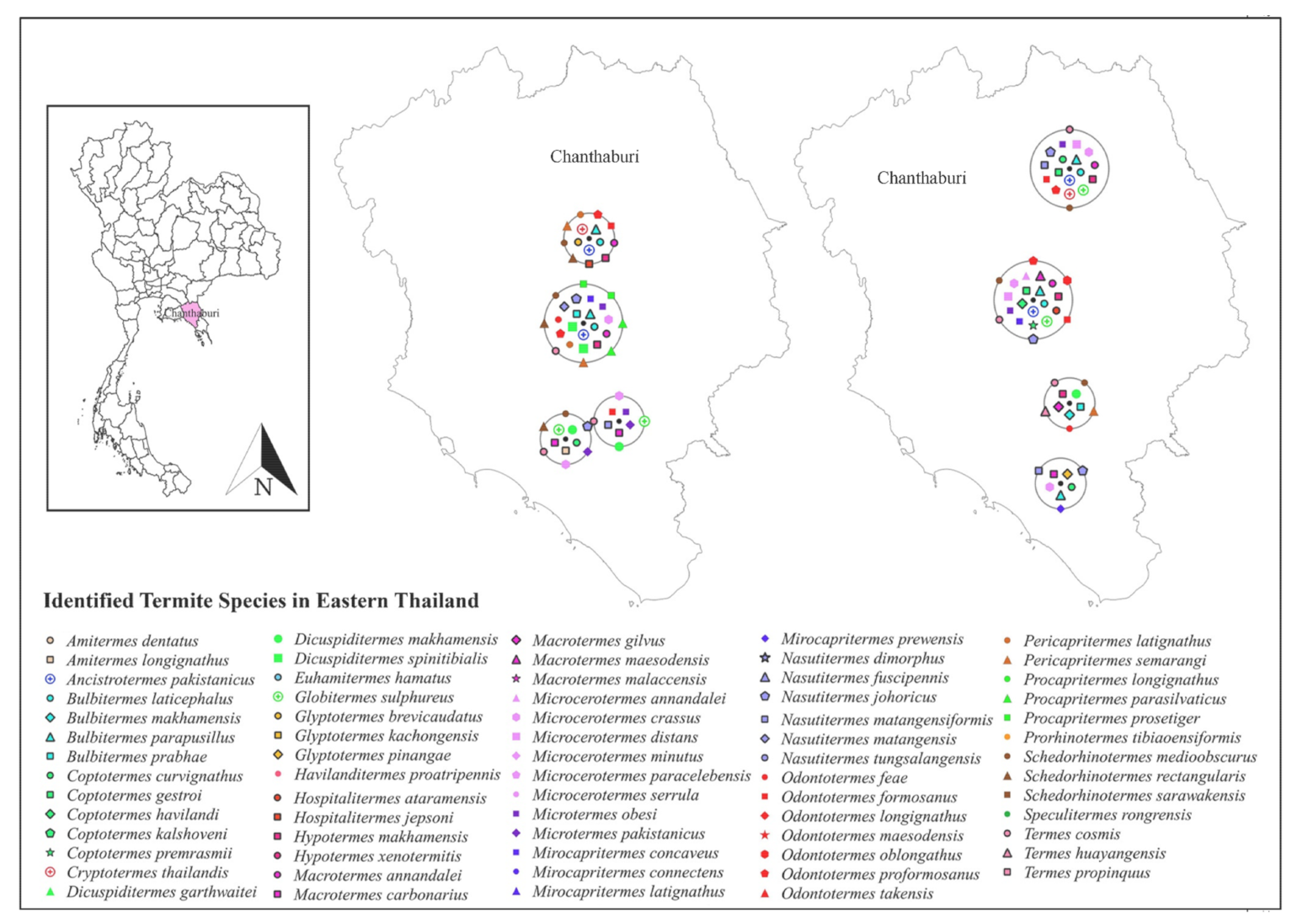
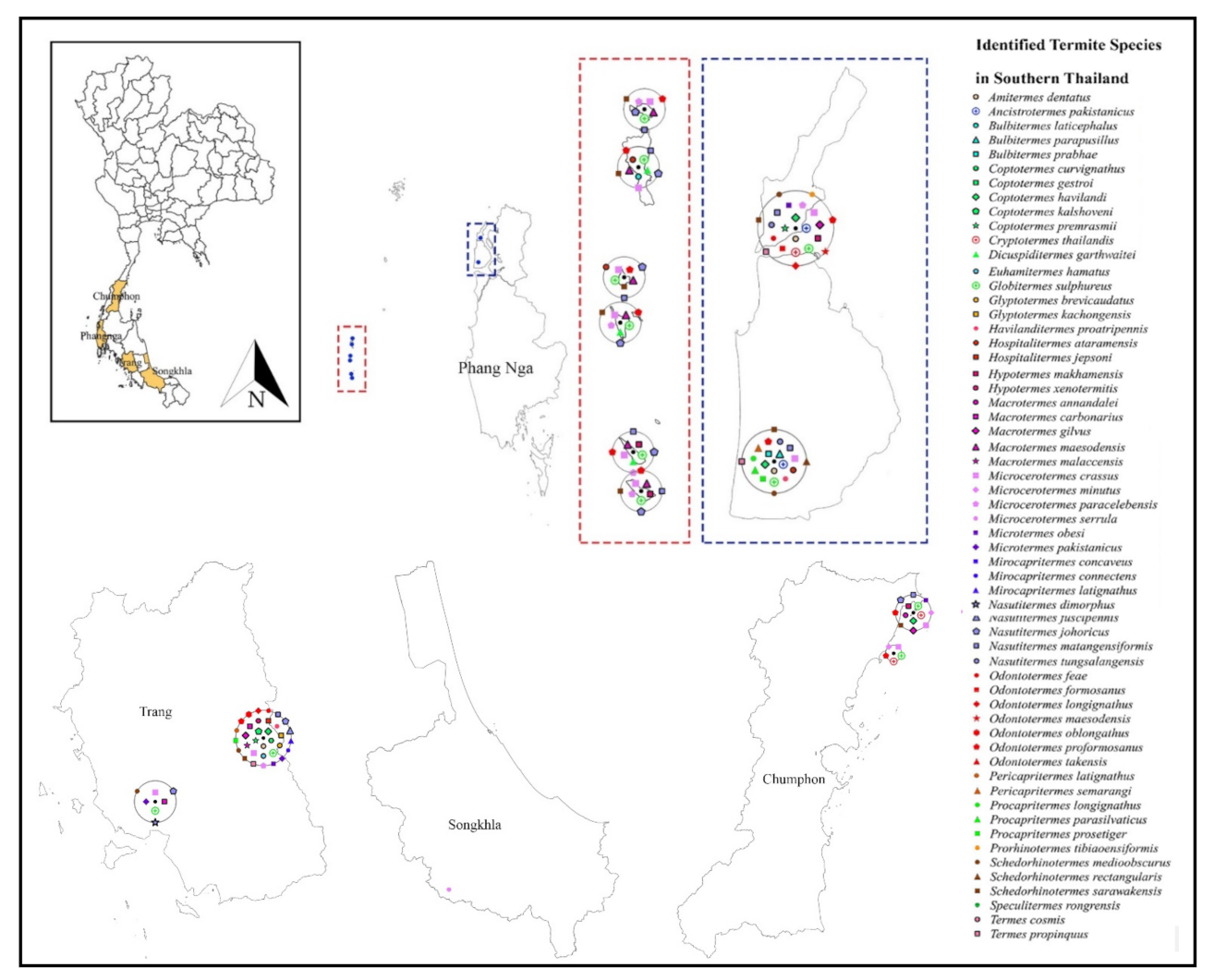
| Species | Regions | |||||
|---|---|---|---|---|---|---|
| Northern | Northeastern | Central | Eastern | Western | Southern | |
| Ancistrotermes pakestanicus | ✓ | ✓ | ✓ | ✓ | ✓ | |
| Bulbitermes laticephalus | ✓ | ✓ | ✓ | ✓ | ✓ | |
| Bulbitermes prabhae | ✓ | ✓ | ✓ | ✓ | ||
| Coptotermes curvignathus | ✓ | ✓ | ✓ | ✓ | ||
| Coptotermes gestroi | ✓ | ✓ | ✓ | ✓ | ✓ | |
| Cryptotermes thailandis | ✓ | ✓ | ||||
| Dicuspiditermes garthwaitei | ✓ | ✓ | ✓ | ✓ | ||
| Globitermes sulphureus | ✓ | ✓ | ✓ | ✓ | ✓ | ✓ |
| Glyptotermes pinangae | ✓ | ✓ | ✓ | |||
| Hospitalitermes ataramensis | ✓ | ✓ | ✓ | ✓ | ✓ | |
| Hypotermes makhamensis | ✓ | ✓ | ✓ | ✓ | ✓ | |
| Macrotermes annandalei | ✓ | ✓ | ✓ | ✓ | ✓ | |
| Macrotermes carbonarius | ✓ | ✓ | ✓ | |||
| Macrotermes gilvus | ✓ | ✓ | ✓ | ✓ | ✓ | ✓ |
| Macrotermes maesodensis | ✓ | ✓ | ✓ | ✓ | ||
| Microcerotermes crassus | ✓ | ✓ | ✓ | ✓ | ✓ | ✓ |
| Microcerotermes minutus | ✓ | ✓ | ✓ | ✓ | ||
| Microtermes obesi | ✓ | ✓ | ✓ | ✓ | ✓ | ✓ |
| Nasutitermes matangensiformis | ✓ | ✓ | ✓ | ✓ | ✓ | |
| Odontotermes feae | ✓ | ✓ | ✓ | ✓ | ✓ | |
| Odontotermes formosanus | ✓ | ✓ | ✓ | ✓ | ✓ | |
| Odontotermes longignathus | ✓ | ✓ | ✓ | ✓ | ✓ | |
| Odontotermes proformosanus | ✓ | ✓ | ✓ | ✓ | ✓ | |
| Pericapritermes latignathus | ✓ | ✓ | ✓ | |||
| Pericapritermes semarangi | ✓ | ✓ | ✓ | ✓ | ✓ | |
| Procapritermes parasilvaticus | ✓ | ✓ | ✓ | ✓ | ||
| Schedorhinotermes medioobscurus | ✓ | ✓ | ✓ | ✓ | ✓ | |
| Termes cosmis | ✓ | ✓ | ✓ | ✓ | ||
Publisher’s Note: MDPI stays neutral with regard to jurisdictional claims in published maps and institutional affiliations. |
© 2022 by the authors. Licensee MDPI, Basel, Switzerland. This article is an open access article distributed under the terms and conditions of the Creative Commons Attribution (CC BY) license (https://creativecommons.org/licenses/by/4.0/).
Share and Cite
Lertlumnaphakul, W.; Ngoen-Klan, R.; Vongkaluang, C.; Chareonviriyaphap, T. A Review of Termite Species and Their Distribution in Thailand. Insects 2022, 13, 186. https://doi.org/10.3390/insects13020186
Lertlumnaphakul W, Ngoen-Klan R, Vongkaluang C, Chareonviriyaphap T. A Review of Termite Species and Their Distribution in Thailand. Insects. 2022; 13(2):186. https://doi.org/10.3390/insects13020186
Chicago/Turabian StyleLertlumnaphakul, Watthanasak, Ratchadawan Ngoen-Klan, Charunee Vongkaluang, and Theeraphap Chareonviriyaphap. 2022. "A Review of Termite Species and Their Distribution in Thailand" Insects 13, no. 2: 186. https://doi.org/10.3390/insects13020186
APA StyleLertlumnaphakul, W., Ngoen-Klan, R., Vongkaluang, C., & Chareonviriyaphap, T. (2022). A Review of Termite Species and Their Distribution in Thailand. Insects, 13(2), 186. https://doi.org/10.3390/insects13020186





